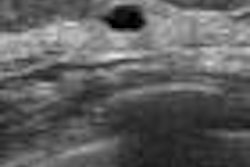The majority of men with small abdominal aortic aneurysms (AAAs) can be followed at longer ultrasound surveillance intervals than are typically used in current AAA screening programs, according to a meta-analysis to be published on Wednesday in the Journal of the American Medical Association.
After collating data on more 15,000 patients from 18 studies, a research team led by Simon Thompson, DSc, of the University of Cambridge in the U.K., determined that rupture rates doubled for each 0.5-cm increase in AAA diameter. To keep rupture rates below 1%, surveillance intervals in men could be extended to eight years for a 3-cm AAA, three years for a 4-cm AAA, and one year for a 5-cm AAA, Thompson said.
"These intervals are substantially longer than those currently being used in most countries," Thompson told AuntMinnie.com. "Lengthening surveillance intervals would decrease medical costs and increase patient convenience, without materially increasing the risk of rupture."
Doesn't apply to women
However, the situation is different for women, the researchers found. Despite having similar AAA growth rates, women included in the study had a fourfold higher risk of AAA rupture than men, Thompson said.
"This means that consideration should be given to changing the threshold for surgical intervention -- which is 5.5 cm in men -- to something smaller in women," he said.
Ultrasound surveillance is used to monitor small AAAs 3 cm to 5.4 cm in diameter. To optimize ultrasound surveillance intervals for small AAAs to limit risk of aneurysm rupture or excessive growth, Thompson and colleagues assessed individual patient data from studies of small AAAs (JAMA, February 27, 2013, Vol. 309:8, pp. 806-813).
After performing a systematic literature search through December 2010, the team contacted study authors and obtained 18 datasets that provided repeated ultrasound measurements of AAA diameter over time in 15,471 patients.
They analyzed AAA diameters with a random-effects model that accounted for between-patient variability in size and growth rate, and then analyzed rupture rates via proportional hazards regression with the modeled AAA diameter as a time-varying covariate. From these results, the researchers estimated the risks of exceeding 5.5 cm in diameter and of rupture within given time intervals, and they pooled the data across studies by random-effects meta-analysis.
AAA growth rates increased an average of 0.59 mm per year (95% confidence interval [CI]: 0.51-0.66), and rupture rates increased by a factor of 1.91 (95% CI: 1.61-2.25) for each 0.5-cm increase in AAA diameter, according to Thompson and colleagues.
Mean years to reach surgical threshold, by AAA diameter
|
Relatively few ruptures were found overall in the study, with just 178 ruptures recorded among 11,262 men and 50 among 1,314 women under surveillance. While absolute growth rates were similar for men and women, marked differences were seen in the absolute rate of rupture, according to the researchers.
"Women had a fourfold greater rupture risk for all AAA sizes and reached a rupture risk of greater than 1% in a much shorter time then men," the authors wrote.
Mean years to reach a 1% chance of rupture, by AAA diameter
|
The findings show that most of the smallest AAAs remain quiescent over many years, and they suggest that surveillance strategies for small AAAs could be refined to reduce the number and frequency of required surveillance scans, the authors concluded.
"Especially for the smallest AAAs, which are the vast majority, intervals substantially longer than is currently the norm are clinically acceptable," Thompson said. "Also, surveillance programs within national screening programs and other national clinical guidelines should be revised to take into account this new evidence.
Regarding future work on AAA, Thompson said he plans to research the pros and cons of changing the surgical threshold in women.




















